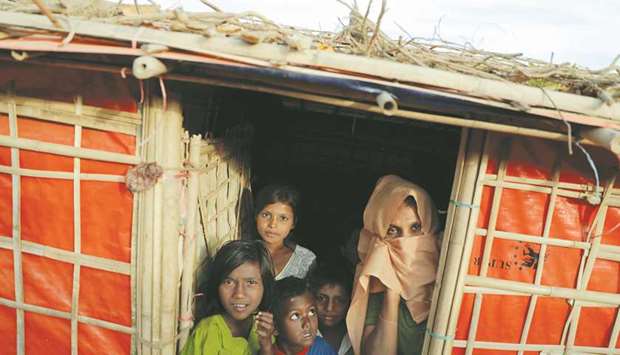They are among more than 625,000 Rohingya Muslims who have fled to Bangladesh since late August, following a crackdown by the Myanmar military in response to attacks on security forces by Rohingya militants.
Roshid Jan, who walked for 10 days with her five children to Bangladesh after soldiers burnt their village, wept when she spoke about her missing husband.
He was accused of being a member of the Rohingya militants and arrested with four other villagers 11 months ago, she said.
She had not seen him or heard about his fate since then.
Aisha Begum, a 19-year-old widow, said her husband was killed by Myanmar soldiers as their band of refugees headed for Bangladesh.
“I was sitting there by his body and just crying, crying, crying,” she said.
“He was caught and killed with knives. I found his body by the road. It was in three pieces,” she cried, recounting the events that brought her to the camp.
Most Rohingya are stateless and seen as illegal immigrants by Buddhist-majority Myanmar.
The United Nations and United States have described the military’s actions as ethnic cleansing, and rights groups have accused the security forces of atrocities, including rape, arson and killings.
Myanmar’s government has denied most of the claims, and the army has said its own probe found no evidence of wrongdoing by troops.
There are 50 tents and no men in the camp for widows and orphans, the biggest of three sites built with donor funds from Pakistan in the refugee settlement of Balukhali not far from Bangladesh’s resort town of Cox’s Bazar.
Two makeshift kitchens provide space for cooking in small holes in the ground, a new well is being dug to supplement a water pump, and a big tent serves for prayers.
The camp is marooned amid ponds and streams of dirty water left by the washing of clothes and dishes. Behind are thousands of dwellings in a vast refugee camp that sprang up during the crisis.
Still, the women are relieved to have their own space.
“For those with no protection, a camp like this is much safer,” said 22-year-old Rabiya Khatun, who lives there with her son. “No man can enter that easily. Also, the rooms are bigger and we have more chances of receiving some aid.”
Women and girls number about 51% of the distressed and traumatised Rohingya population in the Cox’s Bazar camps, the UN Women agency said in October.
“Women and children are also at heightened risk of becoming victims of human trafficking, sexual abuse or child and forced marriage,” it added.
Women and adolescent girls aged between 13 and 20 arriving from Myanmar typically had two to four children each, it said, with some of them pregnant.
No relief agencies officially run the camp for the widows and orphans but aid groups and individuals help out.
Rihana Begum lives with her five children in a room that is bare except for a few tomatoes, some religious books and clothes. On a thin mat lies her daughter, ill with fever, but fear of missing food handouts keeps them away from the doctor.
“I’m afraid to miss aid distribution. I can’t afford to miss it,” she said on the day ration cards from the World Food Program were distributed in the camp.
This week, Myanmar said it was finalising terms for a joint working group with Bangladesh to launch the process of safe and voluntary return of the Rohingya refugees within two months.
That may not be enough to allay Rihana Begum’s fears.
“I’m so afraid that I will never go back to Myanmar,” she said. “I would rather die here.”
Rohingya refugees look from inside their shelter as food ration cards are distributed at the camp for widows and orphans inside the Balukhali camp near Cox’s Bazar, Bangladesh.



